DNAJA1 promotes cancer metastasis through interaction with mutant p53
- PMID: 34183772
- PMCID: PMC8804903
- DOI: 10.1038/s41388-021-01921-3
DNAJA1 promotes cancer metastasis through interaction with mutant p53
Abstract
Accumulation of mutant p53 (mutp53) is crucial for its oncogenic gain of function activity. DNAJA1, a member of J-domain containing proteins or heat shock protein 40, is shown to prevent unfolded mutp53 from proteasomal degradation. However, the biological function of DNAJA1 remains largely unknown. Here we show that DNAJA1 promotes tumor metastasis by accumulating unfolded mutp53. Levels of DNAJA1 in head and neck squamous cell carcinoma (HNSCC) tissues were higher than those in normal tissues. Knockdown of DNAJA1 in HNSCC cell lines carrying unfolded mutp53 significantly decreased the levels of mutp53, filopodia/lamellipodia formation, migratory potential, and active forms of CDC42/RAC1, which were not observed in HNSCC cells with DNA contact mutp53, wild-type p53, or p53 null. Such mutp53-dependent functions of DNAJA1 were supported by the observation that DNAJA1 selectively bound to unfolded mutp53. Moreover, DNAJA1 knockdown in HNSCC cells carrying unfolded mutp53 inhibited primary tumor growth and metastases to the lymph nodes and lungs. Our study suggests that DNAJA1 promotes HNSCC metastasis mainly in a manner dependent on mutp53 status, suggesting DNAJA1 as a potential therapeutic target for HNSCC harboring unfolded mutp53.
© 2021. The Author(s), under exclusive licence to Springer Nature Limited.
Figures
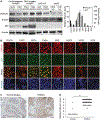
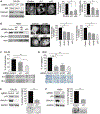
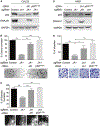

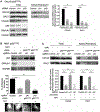
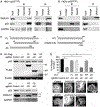
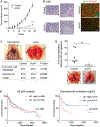
Similar articles
-
Regulation of p53 and Cancer Signaling by Heat Shock Protein 40/J-Domain Protein Family Members.Int J Mol Sci. 2021 Dec 16;22(24):13527. doi: 10.3390/ijms222413527. Int J Mol Sci. 2021. PMID: 34948322 Free PMC article. Review.
-
Identification of a druggable protein-protein interaction site between mutant p53 and its stabilizing chaperone DNAJA1.J Biol Chem. 2021 Jan-Jun;296:100098. doi: 10.1074/jbc.RA120.014749. Epub 2020 Nov 21. J Biol Chem. 2021. PMID: 33208462 Free PMC article.
-
DNAJA1 controls the fate of misfolded mutant p53 through the mevalonate pathway.Nat Cell Biol. 2016 Nov;18(11):1233-1243. doi: 10.1038/ncb3427. Epub 2016 Oct 24. Nat Cell Biol. 2016. PMID: 27775703 Free PMC article.
-
Mutant p53 Depletion by Novel Inhibitors for HSP40/J-Domain Proteins Derived from the Natural Compound Plumbagin.Cancers (Basel). 2022 Aug 29;14(17):4187. doi: 10.3390/cancers14174187. Cancers (Basel). 2022. PMID: 36077724 Free PMC article.
-
Mutant p53 in Cancer: Accumulation, Gain-of-Function, and Therapy.J Mol Biol. 2017 Jun 2;429(11):1595-1606. doi: 10.1016/j.jmb.2017.03.030. Epub 2017 Apr 6. J Mol Biol. 2017. PMID: 28390900 Free PMC article. Review.
Cited by
-
Regulation of p53 and Cancer Signaling by Heat Shock Protein 40/J-Domain Protein Family Members.Int J Mol Sci. 2021 Dec 16;22(24):13527. doi: 10.3390/ijms222413527. Int J Mol Sci. 2021. PMID: 34948322 Free PMC article. Review.
-
Impact of Non-Invasive Physical Plasma on Heat Shock Protein Functionality in Eukaryotic Cells.Biomedicines. 2023 May 18;11(5):1471. doi: 10.3390/biomedicines11051471. Biomedicines. 2023. PMID: 37239142 Free PMC article.
-
Leveraging the Structure of DNAJA1 to Discover Novel Potential Pancreatic Cancer Therapies.Biomolecules. 2022 Sep 29;12(10):1391. doi: 10.3390/biom12101391. Biomolecules. 2022. PMID: 36291603 Free PMC article.
-
Proteomic Identification of Small Extracellular Vesicle Proteins LAMB1 and Histone H4 for Prostate Cancer Diagnosis and Risk Stratification.Adv Sci (Weinh). 2024 Jun;11(23):e2402509. doi: 10.1002/advs.202402509. Epub 2024 Apr 8. Adv Sci (Weinh). 2024. PMID: 38590132 Free PMC article.
-
DNAJA1 Stabilizes EF1A1 to Promote Cell Proliferation and Metastasis of Liver Cancer Mediated by miR-205-5p.J Oncol. 2022 May 9;2022:2292481. doi: 10.1155/2022/2292481. eCollection 2022. J Oncol. 2022. PMID: 35586205 Free PMC article.
References
-
- Cyr DM, Ramos CH. Specification of Hsp70 function by type I and type II Hsp40. Subcell Biochem. 2015;78:91–102. - PubMed
-
- Hartl FU, Bracher A, Hayer-Hartl M. Molecular chaperones in protein folding and proteostasis. Nature. 2011;475:324–32. - PubMed
-
- Large AT, Goldberg MD, Lund PA. Chaperones and protein folding in the archaea. Biochem Soc Trans. 2009;37:46–51. - PubMed
-
- Chen CY, Jan CI, Lo JF, Yang SC, Chang YL, Pan SH, et al. Tid1-L inhibits EGFR signaling in lung adenocarcinoma by enhancing EGFR Ubiquitinylation and degradation. Cancer Res. 2013;73:4009–19. - PubMed
Publication types
MeSH terms
Substances
Grants and funding
LinkOut - more resources
Full Text Sources
Other Literature Sources
Medical
Research Materials
Miscellaneous

